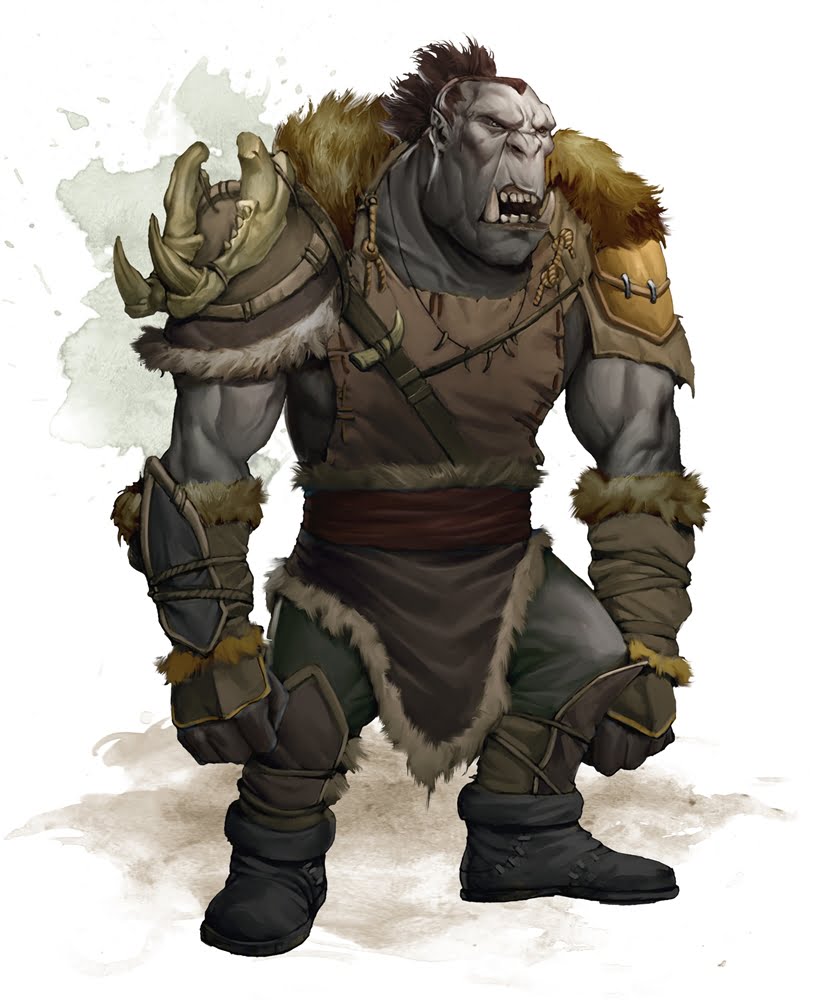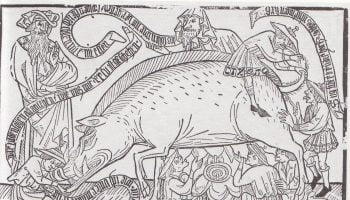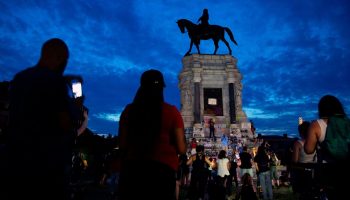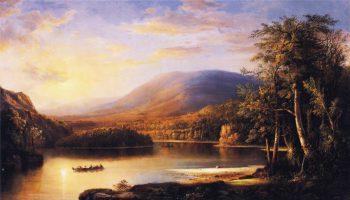This article is part 47 of The Public Medievalist’s series on Race, Racism and the Middle Ages, by Paul B. Sturtevant. Find the rest of the series here.
Dungeons and Dragons is massively popular—probably the most popular fantasy rehash of the Middle Ages in the world today. Whereas prior editions of the game had long been a mainstay in hardcore “nerd” cultures, the current 5th edition of D&D (published in 2014) has found a much broader audience. A-list celebrities play D&D. And professional D&D players—like the casts of popular Twitch show Critical Role or the podcast The Adventure Zone—have become celebrities. During the pandemic, D&D’s popularity has only grown as friends and family look for new ways to keep connected.
But D&D is also going through a long overdue reckoning. As I wrote in 2017 here on The Public Medievalist, the game has racism built into some of its core aspects. I am far from alone in pointing this out. Several other members of the D&D gaming community—particularly people of color—have been doing the hard work of calling this out amidst a fan culture that can be deeply hostile to criticisms. James Mendez Hodes wrote a pair of must-read articles exposing the racist and colonialist underpinnings of Orcs. Graeme Barber wrote an excellent piece in February of 2019 on how D&D deals with “half-“ races (i.e., half-elves, half-orcs, etc.), replicates deeply racist ideas around miscegenation. Roleplaying game designers, players, and communities took to social media to discuss these issues and press Wizards of the Coast, the company that publishes Dungeons and Dragons, to make changes.
And they did.
In June 2020, they published an article on their website that outlined those changes: discontinuing links between race and morality (i.e., orcs aren’t an “evil race”), allowing players to decouple race and ability scores (so orcs are not, by definition, stronger than others), and making other changes to remove some of the obvious racism from their published adventures in consultation with sensitivity readers and consultants. They recently published a new supplement book, Tasha’s Cauldron of Everything, which gives players the option to further decouple their character’s abilities from their race.
To which I reply: good start. Keep going.
There’s a lot more racism baked into the core of D&D—and by extension, the whole fantasy genre—that needs to be addressed. As a start, let’s talk about barbarians.
“I Would Like to Rage”
Note: If you play D&D and know all about how barbarians work in it, feel free to skip this section. I won’t be offended.

For those of you who don’t play D&D, when you hear the word “barbarian”, the first thing that likely comes to mind is “Conan.” And the Conan who is lodged there is probably not from the original stories by Robert E. Howard (who was, himself, disgustingly racist). It’s more likely the Conan of the popular Arnold Schwarzenegger films from 1982 and 1984 (which had the good sense to ditch the racism). Or, if you’re into deep nerdy cuts, maybe you think of the Marvel Comics run from 1970–1993. But while Arnold’s tanned, hairless and be-loinclothed Cimmerian is the key cultural touchstone for most American ideas of “barbarian”, the current version of D&D seems to draw from two entirely different sources. The first is early medieval Old Norse accounts of “berserkers.” The second is racist depictions of Indigenous peoples.
The key thing that sets the “barbarian” class (i.e., the archetype a player can choose for their character) apart from the “fighter” class in D&D is that barbarians can activate an intense “rage” that gives them special powers. But that is not all that sets them apart. While “fighters” come from all cultures, The Player’s Handbook (one of the three core rulebooks for D&D) specifies that barbarians only come from “savage” “tribes” that lie outside of “civilization”.
This is how they are introduced:
A tall human tribesman strides through a blizzard, draped in fur and hefting his axe. He laughs as he charges toward the frost giant who dared poach his people’s elk herd.
A half-orc snarls at the latest challenger to her authority over their savage tribe, ready to break his neck with her bare hands as she did to the last six rivals.
Frothing at the mouth, a dwarf slams his helmet into the face of his Drow foe, then turns to drive his armored elbow into the gut of another.
These barbarians, different as they might be, are defined by their rage: unbridled, unquenchable, and unthinking fury. More than a mere emotion, their anger is the ferocity of a cornered predator, the unrelenting assault of a storm, the churning turmoil of the sea.
For some, their rage springs from a communion with fierce animal spirits. Others draw from a roiling reservoir of anger at a world full of pain. For every barbarian, rage is a power that fuels not just a battle frenzy but also uncanny reflexes, resilience, and feats of strength.
In core D&D, there is a central worldview that states the world is split into those who are “civilized” and those who are not. The “barbarian” way of life is, according to the Handbook more authentic and “natural”.
People of towns and cities take pride in how their civilized ways set them apart from animals, as if denying one’s own nature was a mark of superiority. To a barbarian, though, civilization is no virtue, but a sign of weakness. The strong embrace their animal nature—keen instincts, primal physicality, and ferocious rage. Barbarians are uncomfortable when hedged in by walls and crowds. They thrive in the wilds of their homelands: the tundra, jungle, or grasslands where their tribes live and hunt.
These barbarians are not just skilled warriors, they are animalistic. They are not just natural, they are a force of nature.
Barbarians come alive in the chaos of combat. They can enter a berserk state where rage takes over, giving them superhuman strength and resilience. A barbarian can draw on this reservoir of fury only a few times without resting, but those few rages are usually sufficient to defeat whatever threats arise.
They are not governed by reason, but by emotion—or at least the one emotion that is socially acceptable in the framework of toxic masculinity: rage.
And as a player progresses in the barbarian class, they are asked to choose a “primal path”—a subclass—that gives them special powers through the remainder of the game. Though more have been added in supplemental books, the Player’s Handbook features two. One is drawn from Norse history and myth: the “Path of the Berserker”. The other culturally appropriates Indigenous cultural and religious practices: the “Path of the Totem Warrior.”
Norse Barbarians: Viking Berserkers
his men rushed forwards without armour, were as mad as dogs or wolves, bit their shields, and were strong as bears or wild bulls, and killed people at a blow, but neither fire nor iron told upon themselves. These were called Berserker.
—Snorri Sturllson, Ynglinga saga, trans: Samuel Laing
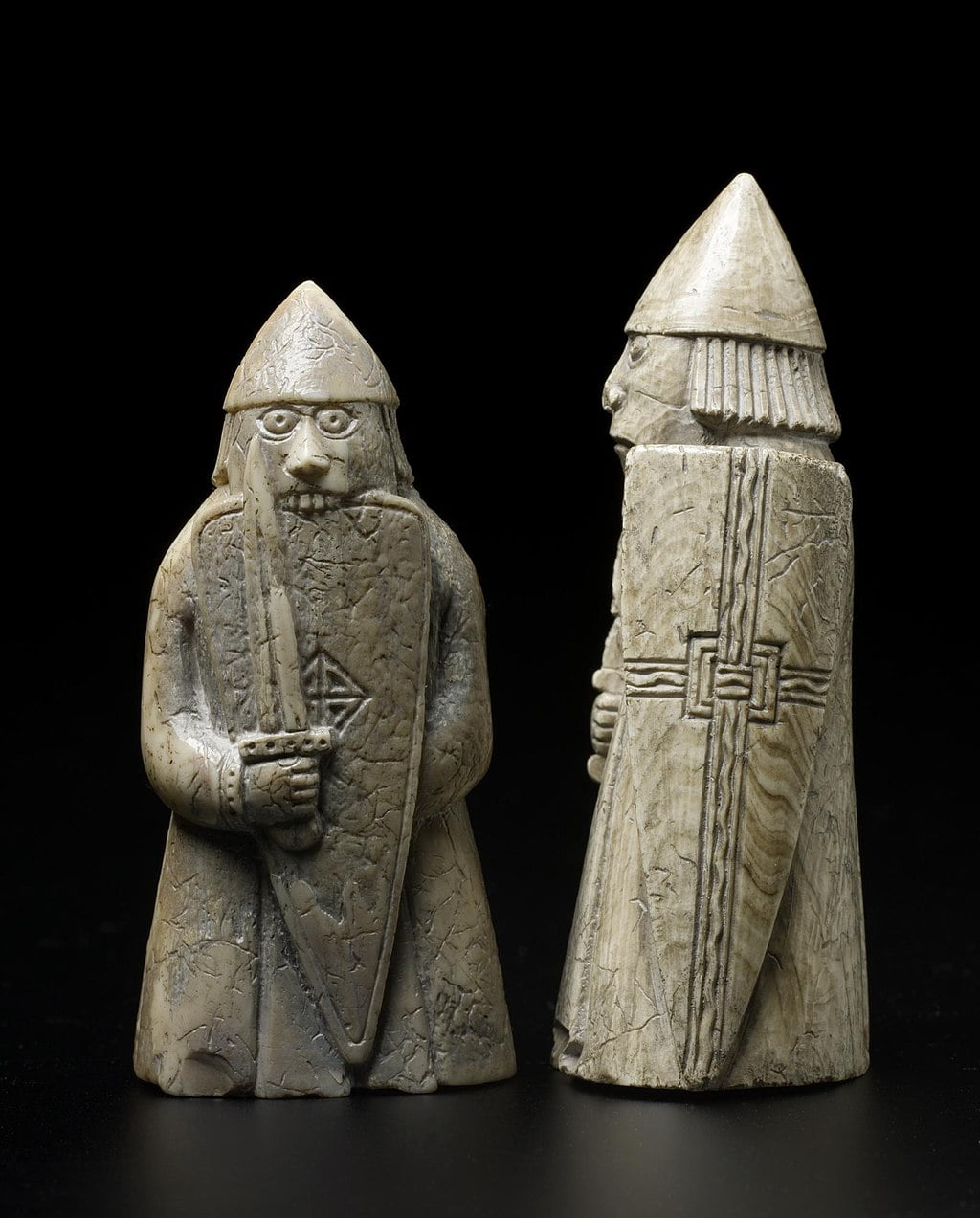
Let’s look at the far less racist one first, shall we?
Though they sound like something drawn from fantasy literature, “berserkers” are well-attested in the Norse accounts of their history and legends: the Sagas. Of course, many of these sagas incorporate mythological or supernatural elements and were written down hundreds of years after the events they describe. So, the accounts of the berserkers found there should be taken with a huge grain of salt.
The origin of the word “berserker” gives you a sense of who they were to a medieval Norse person. The suffix “serker” is clear—it means “shirt”. The “ber” prefix is less clear—either meaning “bare” or “bear”. If “bare”, this may be because they were supposedly invincible warriors who did not need armor (though in some stories they do wear it). If “bear”, this may be because they are often associated both with the worship of Odin and the worship of bears; it may indicate that they wore bear skins, and scholars have linked them with similar early medieval traditions of people wearing wolf skins into battle.
Some berserkers were said to have magical powers: Bödvar Bjarki, one of the heroes of the Saga of King Hrolf Kraki (Hrólfs saga kraka), could shapeshift into a bear (remember that grain of salt?), which made him undefeatable in battle:
King Hjorvarth and his men saw how a huge bear advanced before king Hrolf’s men, and always next at hand where the kind was. He killed more men with paw of his than any five of the king’s champions. Blows and missiles rebounded from him, and he beat down both men and horses
Incidentally, this is likely where J.R.R. Tolkien drew inspiration for the shape-shifting warrior Beorn, in The Hobbit, which has since given us bear shapeshifters like in the Pixar film Brave or even the werebear monster in D&D itself.
The less-magical common thread that unites these bear-warriors of Odin was how they fought. According Arwen van Zanten in her article ‘Going Berserk: In Old Norse, Old Irish and Anglo-Saxon Literature,’ they would fly into
a battle rage that is often uncontrollable, indiscriminate and accompanied by some sort of feral transformation. This battle rage is often initiated by howling, being insulted, or (in)directly threatened.
Some scholars have taken the literary accounts literally, trying to find explanations for this battle rage. Some have theorized it may have been drug-induced, whereas others have looked to psychological causes like PTSD.
But it’s also possible they didn’t exist at all. Berserkers were something of a stock character in Norse literature, and their role in stories changed over time. In some Old Norse stories, they are similar to D&D’s barbarians: terrifying warriors set apart from society, or particularly fearsome bandits. But sometimes they appear in a king’s retinue or as the king’s personal bodyguard. In those, they either have to be defeated by the hero in the story (“The Worf Effect”), or ultimately become friends with the hero. One example comes from the Saga of Hrólfr Kraki:
The leader of the berserkers stood, asking each man seated before him if he reckoned himself an equal… Then the berserker’s leader came to Svipdag, asking whether he thought himself an equal. Svipdag leapt up and drew his sword, claiming that he was in no way less than the berserker.
The berserker replied, ‘Then strike at my helmet.’ Svipdag did so but his sword did not cut into the helmet. The two men then got ready to fight.
King Hrolf, quickly positioning himself between the two, forbade their fighting. He said that they should be called equal from now on, declaring them ‘both my friends.’ Thus the two, accepting equality, were reconciled. From that time on they were always in agreement, standing together in war and winning victory wherever they went.
In other stories, they serve a similar Worf-Effect role: the berserker is an unwanted suitor who, as Benjamin Blaney wrote,
Where he challenges a man (usually either very old or very young) to a duel for the man’s property, wife, and/or daughter. A hero, usually a visitor in the home of the challenged man, replaces his host in the duel, slays the berserkr, and thus wins for himself fame, fortune, and often also a wife.
And when Christianity came to Scandinavia and the worship of Odin became less and less socially acceptable, the berserker’s place in fiction changed too—as Blaney writes, instead of being slain by the physical prowess of the hero:
he becomes the foil for Christian missionaries who slay berserkír, thus convincing the heathen of Christ’s superiority.
It’s difficult—perhaps impossible—to know the degree to which berserkers were real. Maybe they are stock characters that take the same role that “The Big Guy” or “the Giant Mook” play in our fictions today. But overall, the adaptation of berserkers for Dungeons and Dragons maps pretty closely onto the medieval source material, at least in terms of their battle prowess.
However, the cultural descriptions of “barbarians” (and the word “barbarian” itself) don’t really apply to Norse Vikings. Despite what their opponents might have felt, the Vikings were far from “savage”. They lived in rival kingdoms, not “tribes.” The Player’s Handbook says that barbarians
thrive in the wilds of their homelands: the tundra, jungle, or grasslands where their tribes live and hunt.
Sure, Scandinavia is cold (though during the “Medieval Warm Period” in the Middle Ages it was a lot warmer than it is today). But southern Scandinavia, where Vikings thrived, is no tundra. Vikings were hunters; all medieval societies were. But they were not a hunter-gatherer society like the Player’s Handbook implies. And though they lived in Northern Europe, they were not a peripheral people. Their maritime empire of trade, conquest, and raiding made them a center of power. Their Christian foes thought them “uncivilized,” but in reality they were better groomed and more technologically and culturally advanced than some of their neighbors—not least because of their regular contact with other cultures like the Greek Byzantines and the Muslim world.
So what causes the difference?
D&D, Barbarians, and Anti-Indigenous Racism
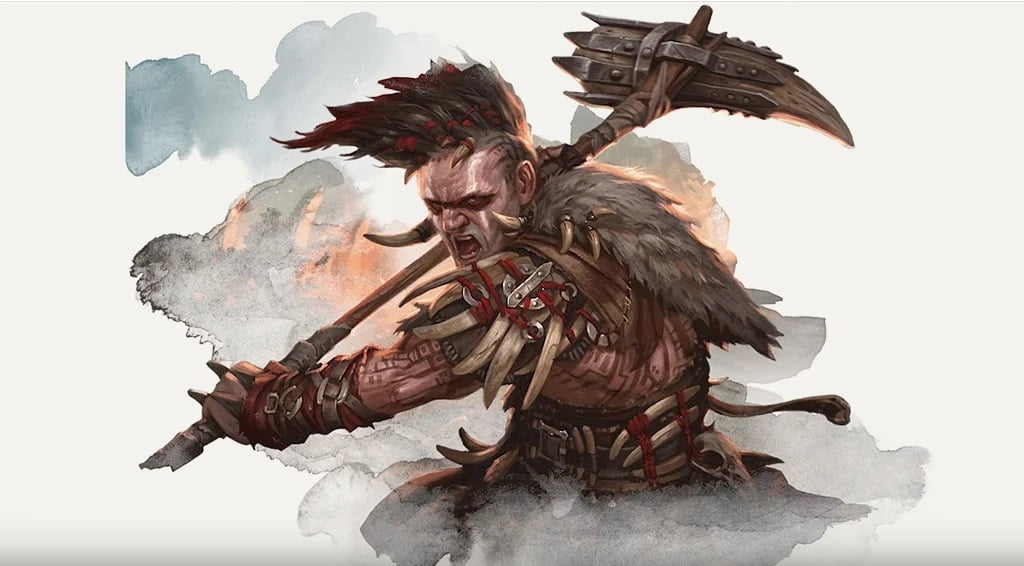
The aspects of D&D barbarians that don’t fit with the Norse Berserker tradition reveal their other, more troubling, source: racist images of Indigenous peoples. The descriptions in the Player’s Handbook are profoundly loaded because they have been used to dehumanize and justify the genocide of Native Americans and other Indigenous peoples around the world.
Take, for instance, the repeated use of the word “tribe.” The word originates from the Latin tribus, and first comes into English in the 12th century in a description of the twelve tribes of Israel. But because of its consistent use by colonizers and anthropologists, the word has been inextricably linked with the Indigenous peoples of the Americas, of Africa, and of the Pacific Islands. The descriptions in the book of barbarians hailing from:
their homelands: the tundra, jungle, or grasslands
neatly maps onto this. The Vikings did not live in the tundra. But the Saami, Inuit, Iñupiat, Yupik, Aleut and other Indigenous peoples of the Arctic did and still do. The “jungle” is clearly meant to evoke Central Africa as seen in Heart of Darkness or the Caribbean of Robinson Crusoe, while “grasslands” tribes evoke the Maasai of Africa or the Indigenous peoples of the great plains and prairies of North America.
And perhaps the most telling word of all is “savage.”
“Savage”
The word “savage” is the oldest slur in the book against Indigenous peoples. It creates a world split in two: between colonizer and colonized, civilization and primitivism, and, by extension, good and evil. This imaginary split has been used to justify every manner of atrocity leveled against Indigenous peoples. Many White Europeans called American Indians and other Indigenous peoples “savages” in order to reimagine their own acts of brutality, theft, and mass-murder as “bringing civilization.” White Europeans also called Africans “savages” to mentally paper over enslaving them, attacking their language, culture, and religion, and raping and murdering them. You see the same story in India, in Southeast Asia, Oceania, and in all places touched by the European colonial project. In his book Armies of the Raj, Historian Byron Farwell quotes one particularly potent example of this idea, from an 1855 report by the British Chief Commissioner of the Punjab (in India):
Now these tribes are savages—noble savages, perhaps—and not without some tincture of virtue and generosity, but still absolute barbarians nevertheless. … They have nominally a religion … [but] in their eyes the one great commandment is blood for blood, and fire and sword for all infidels.
This idea of Indigenous savagery in warfare was emblematized with the association of scalping with Native Americans. In reality, it was more common to find European colonies paying bounties for the scalps of Indian men, women and children. As Indian Country Today put it:
The Dutch governor of Manhattan, Willem Kieft, offered the first bounty in North America for Indian scalps in 1641, only 21 years after the Puritans landed at Plymouth Rock. The Massachusetts Bay Colony first offered $60 per Indian scalp in 1703. The English and the French introduced scalping to Indians. The governors of the colonies instituted scalping as a way for one Indian tribe to help them eliminate another tribe, and to have colonists eliminate as many Indians as possible.
But, you may be thinking: Conan, Wulfgar, Yasha, Grog, and the barbarians you create in Dungeons and Dragons are heroes, not villains! Quite true. That’s where the trope of the “noble savage” comes in.
As the European machines of war and colonialism spread across the world in the 18th and 19th century, the idea of the universal “savage” grew and changed. Anthropologist Ad Borsboom explains in his article “The Savage in European Social Thought”:
On the one hand the contrast with European civilization has been phrased in negative terms: no progress but stagnation; not civilized but cruel and primitive; no history but timelessness; not logical but pre-logical. In this respect the concepts ‘Primitive’ and ‘Savage’ were antipodes of the European situation and they formed a legitimation for the European process of civilization.
But, in the late 18th century, a shift occurred, as Borsboom notes, recasting these societies as “Children of Nature” who persisted in a “natural state, free from the oppressive bonds of civilization.”
Thus, Indigenous peoples became romanticized. First it was the American Indians, then Pacific Islanders. European thinkers also reconfigured the “barbarians” who dismantled the Western Roman Empire into hypermasculine Germanic he-men, and held up the European Middle Ages as a more “natural” way of life.
But Europeans were capable of holding two contrasting ideas in their minds at once. Indigenous people were painted as both “noble” and “savage.” Just because Europeans waxed nostalgic about their way of life did not mean they didn’t also think that way of life should be destroyed. The “noble savage” trope is ultimately just as objectifying and denigrating as its “ignoble savage” counterpart—like all “Credit to Your Race” and “Magical Minority” tropes.
Across the three core D&D 5th edition books (the Player’s Handbook, the Dungeon Master’s Guide, and the Monster Manual), the word “savage” appears 32 times. More often than not, it is used to describe humanoid monsters, particularly ones coded as racially “other.” Its use reveals the worldview that is built into Dungeons and Dragons: a dichotomy between “civilization” and “savages”, where savagery, more often than not, makes something worthy of death.
The word is most often applied to orcs and half-orcs. Several essays (like this excellent one by James Mendez Hodes) have laid out plainly how orcs have long been coded as people of color. This is true in D&D, and has deep roots that go back to the father of the genre, J.R.R. Tolkien.
But the word is also used to describe other humanoid monsters in the Monster Manual like werewolves, ogres, and hill giants. Minotaurs are described as “savage conquerors and carnivores that live for the hunt.” But, for some reason, the book goes on to say their fur can be one of two colors: “brown or black.” Apparently the author could not imagine a white cow—despite the fact that in the original myth of the Minotaur, its father was a “dazzlingly white bull.”
Trogolodytes are not just described as “savage” but with another word that also has deep anti-Indigenous roots: “degenerate.” The theory of degeneration was developed first in the 18th century by European thinkers eager to believe that everything—and everyone—in the New World was weaker and less capable. In particular, degeneration theory promoted the dehumanizing and racist idea that the Indigenous peoples of the Americas were incapable of feeling emotions. The description of Troglodytes in the Monster Manual could be ripped from the pages of a degeneration theorist, or perhaps the Commissioner for the Punjab quoted above:
Perhaps the most loathsome of all humanoids… [they] have a simple, communal culture… Too simple to plan more than a few days in to the future, troglodytes rely on constant raids and hunting to survive… and show no mercy toward those they capture […they] make little and build less, scavenging their possessions from their prey.
Cultures, both historical and present-day, cannot and should not be judged to be more or less “civilized.” Cultures can be described in a wide range of ways: agrarian or urbanized; nomadic or sedentary; pluralistic or exclusionary; hierarchical or communal, and many more. But none of those are a judgement on “civilization,” because the very concept of “civilized” vs. “uncivilized” was invented as a way of marking others for extermination. Whether a particular “barbarian” in D&D is a “noble savage” or a monstrous ignoble one, the idea of savagery vs. civilization is fundamentally structured around this genocidal ideology.
D&D and Indigenous Cultural Appropriation
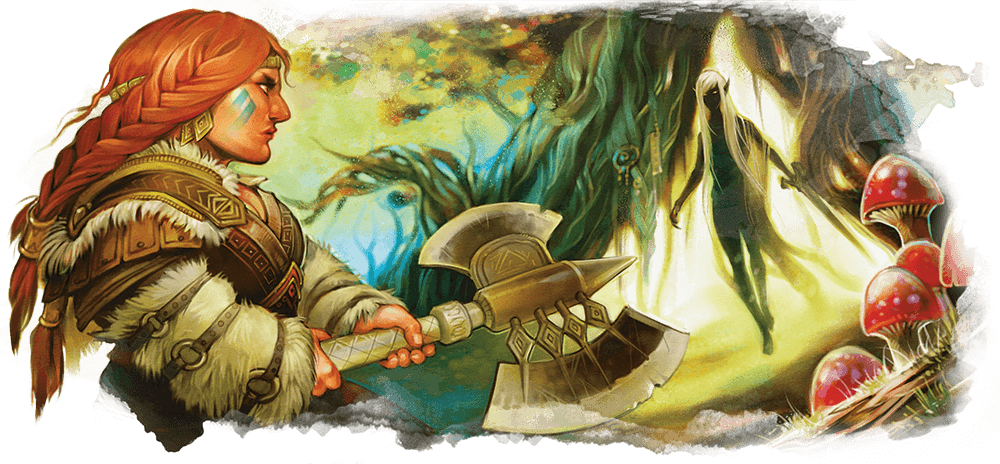
Because of their associations of the barbarian class with Indigenous peoples, the descriptions in the Player’s Handbook of Barbarians being proudly uncivilized and animalistic becomes rather yikes-worthy pretty quickly. But adding to the yikes is a heaping helping of cultural appropriation in the form of the “Path of the Totem Warrior” subclass:
The Path of the Totem Warrior is a spiritual journey, as a barbarian accepts a spirit animal as a guide, protector, and inspiration. In battle, your totem spirit fills you with supernatural might, adding magical fuel to your barbarian rage. Most barbarian tribes consider a totem animal to be kin to a particular clan. In such cases, it is unusual for an individual to have more than one totem animal spirit, though exceptions exist.
The idea of a “spirit animal,” “totem animal,” “spirit helper” and similar ideas come from a long and diverse range of Native American and First Nations spiritual practices. Tristan Picotte on the “Partnership with Native Americans” blog writes:
In my teachings, a Spirit Helper isn’t something you choose or identify with but rather something that comes to you in your time of need. Perhaps the animal represents something that holds a certain value, such as strength in a bull or agility in a dragonfly. [In] Lakota culture, it’s from these spirits that we tend to associate values with certain animals. However, that’s not all they bring.
Spirit Helpers are not a novelty. They hold a special place and represent a larger spiritual culture within a tribe. Many people don’t take the time to really understand this, and the adapted understanding and misappropriation is concerning and often offensive to Native cultures.
But the way that “spirit animal” has been appropriated by white people, first by the “New Age” and “spiritualist” movement, then by internet meme culture, is deeply reductive and offensive. In an interview, Terry Snowball (Prairie Band Potawatomi/ Wisconsin Ho-Chunk), Repatriation Coordinator at the Smithsonian National Museum of the American Indian, explained why:
Using something like a spirit animal in a game is one tip of one iceberg.
People say, ‘Well what does that hurt if people take an aspect of our religious practice or tradition and incorporates it into something else?’ It’s the decontextualization… So the things that get appropriated, while they don’t seem to harm the things you’re deconstructing, it does in the sense that it diminishes the power of it. It takes away that power, because you’re using it for something else. Look at the sacraments you have in [Christian] church. If you were to take those and do something else with them, there would be a total controversy.”
This is further complicated by the fact that Native beliefs and practices, like that of the spirit animal, have been actively persecuted much more recently than you might think. Native people were not permitted to practice their religions freely in the United States until 1978. Mr Snowball continued:
Native people in this country were persecuted, and their ways and traditions were demonized. Policies were implemented to strip the ‘self’ away. There are various forms of treatment—extermination, assimilation. All these things represent degradations, until the Religious Freedom Act restored some of those things, many of these practices and traditions were practiced secretly.”
Mr. Snowball also discussed how they were also not permitted to engage with the sacred artifacts that had been taken from them and put in museums:
“A good majority of the discourse that’s taken place has been with Westerners: ethnographers, historians, archaeologists, anthropologists, so it’s very much still hostage—in one sense it is sort of proprietary, because Indians weren’t even allowed to go into museums to access their sacred items that were once theirs, that they were dispossessed of.”
In spite of this, according to Mr. Snowball, people—whether New Age practitioners or game companies—feel entitled to appropriate Native culture in a way they would not with other pieces of history:
People get unnerved when Native people tell non-Native people not to do something, because they think they’re entitled to it, it’s their right.
But let’s take the example; if someone were to make a game about the Holocaust, and how many people you could kill in a concentration camp. How far would that get as an idea? It’s been such an important part of history—it was something truly inhumane. But that’s occurred more than once.
Native activists and allies have publicly corrected celebrities who have misused the idea of the spirit animal on social media. But a simple search on Twitter shows that many have not gotten the message.
The Smithsonian National Museum of the American Indian produced teaching materials titled “Not Your ‘Spirit Animal’” meant to guide teachers in helping their students understand:
Indigenous peoples’ relationships with animals are the result of tens of thousands of years of connections to their environments. The non-Native concept of “spirit animals” has seen a recent rise in popularity, in and out of the classroom. Finding animals they connect with can be a fun activity for many students. However, using the concept of a “spirit animal” while teaching Native American culture trivializes Native relationships to the animal world.
And some tribes have taken this very seriously indeed. In 1993, about five hundred leaders from the Lakota, Nakota and Dakota Nations unanimously endorsed a “Declaration of War Against Exploiters of Lakota Spirituality.” It is a powerful statement that deserves to be read in its entirety. But for our purposes, it explicitly condemns:
having our most precious Lakota ceremonies and spiritual practices desecrated, mocked and abused by non-Indian “wannabes”, hucksters, cultists, commercial profiteers and self-styled “New Age shamans” and their followers
And it also calls out how some:
have exploited the spiritual traditions of our Lakota people by imitating our ceremonial ways and by mixing such imitation rituals with non-Indian occult practices in an offensive and harmful pseudo-religious hodge-podge
And states:
We hereby and henceforth declare war against all persons who persist in exploiting, abusing and misrepresenting the sacred traditions and spiritual practices of our Lakota, Dakota and Nakota people.
So maybe, just maybe, the “Path of the Totem Warrior” shouldn’t be a part of the “barbarian” class in D&D. Because of its caricaturing of Native people and appropriation of their culture, as it stands, the barbarian class is the “The Washington Redskins” of Dungeons and Dragons. It must be changed.
What Should You Do?
That very much depends on who you are.
If you are an Indigenous player of D&D:
- You do you.
If you not an Indigenous player of D&D:
If you are not wedded to the D&D system, check out some of the other TTRPGs that have been made by Native creators. For example, check out Ehdrigohr, a campaign setting that describes itself as:
Culturally, Ehdrigohr is a non-traditional fantasy world. Rather than fantasy seen through a Euro-Medieval lens, Ehdrigohr is instead crafted to take inspiration from the myth and folklore of tribal, and indigenous, cultures from around the world.
Alternatively, consider backing the Kickstarter for Coyote & Crow, a new RPG setting made by a team of Native creators, set in a sci-fi vision of an uncolonized Americas:
Coyote and Crow is a tabletop role playing game set in an alternate future of the Americas where colonization never occurred. Instead, advanced civilizations arose over hundreds of years after a massive climate disaster changed the history of the planet. You’ll play as adventurers starting out in the city of Cahokia, a bustling, diverse metropolis along the Mississippi River. It’s a world of science and spirituality where the future of technology and legends of the past will collide.
If you are committed to using D&D, one of the truly great things about D&D is how flexible it is; the books offer a starting point and a guide, but the game is infinitely malleable in the hands of the players. So just because the guide books are problematic doesn’t mean you have to take them word for word. Every table has different house rules. Consider adopting some of these:
- If you are a DM, create worlds that are not bound to a “civilized/uncivilized” dichotomy. Create a tapestry of different cultures with varying attributes. If someone in your world labels a people “uncivilized,” make sure it’s clearly an antagonist and that their ideas are shown to be toxic. Or maybe just don’t include that kind of thinking at all.
- If you want to use the Barbarian class, make them universal rather than specific to rural or nomadic cultures. Maybe the chosen followers of a war god are blessed with invulnerable rage? Achilles from Homer’s Iliad fits the bill as a nigh-invincible warrior driven by fury, with bonus Brad Pitt. Lancelot goes battle-mad a few times in the medieval Arthurian stories (though it often doesn’t end well). Ashwatthama, from the great ancient Indian epic The Mahabharata, also enters an unstoppable battle-rage, and he was nobody’s barbarian. You have plenty of historical and literary archetypes to choose from.
- Avoid the “Orc/Half-orc Barbarian” stereotype.
- Banish the words “savage,” and “degenerate” from your vocabulary.
- Be very careful about using the word “tribe,” as in modern usage it’s culturally specific. Better to use “clan” or “chiefdom.”
- Don’t use the “Path of the Totem Warrior” subclass.
- Or, perhaps, choose another roleplaying game altogether.
If your name is Jeremy Crawford (or you work at Wizards of the Coast):
Thanks for reading. Glad you made it this far.
- Don’t use the words “savage” or “degenerate” anymore, especially when referring to humanoids.
- Consider renaming the “Barbarian” class.
- Scrap the “Path of the Totem Warrior” and apologize to Indigenous people you may have offended. Rihanna did it. You can do it.
- If you want to include Indigenous stories and legends in D&D (which is important since nobody wants D&D to be centered on white stories), then hire Indigenous people on the creative team and empower them to represent their own culture in the game.
- But when you do so, understand that there is a huge diversity of Indigenous Nations and Tribes; don’t try to represent them all in a “hodge-podge.” Encourage and empower your creatives to be as culturally specific as possible. And don’t amalgamate them with other cultures like with the Norse/Indigenous hybrid barbarian.
- At the very least, reach out to the Smithsonian; as Mr. Snowball said, the National Museum of the American Indian has experience working with companies: “Our museum has made partnerships with various companies to address their use, and advise about what is culturally sensitive and appropriate representations [of Native people]. There’s either the change they want to make for themselves to correct what they’ve done in the past, or they’re being equally respectful by saying ‘we don’t want to make the mistakes others are making.’”
- Recognize that making D&D anti-racist and anti-colonial is going to require a lot of work; it may cost money. It may cost you players in the short run. But in the long run, you know that being more expansive and inclusive is not just a moral good, but is the only way to ensure that your game keeps being embraced by new communities and the next generation.
Good luck.

